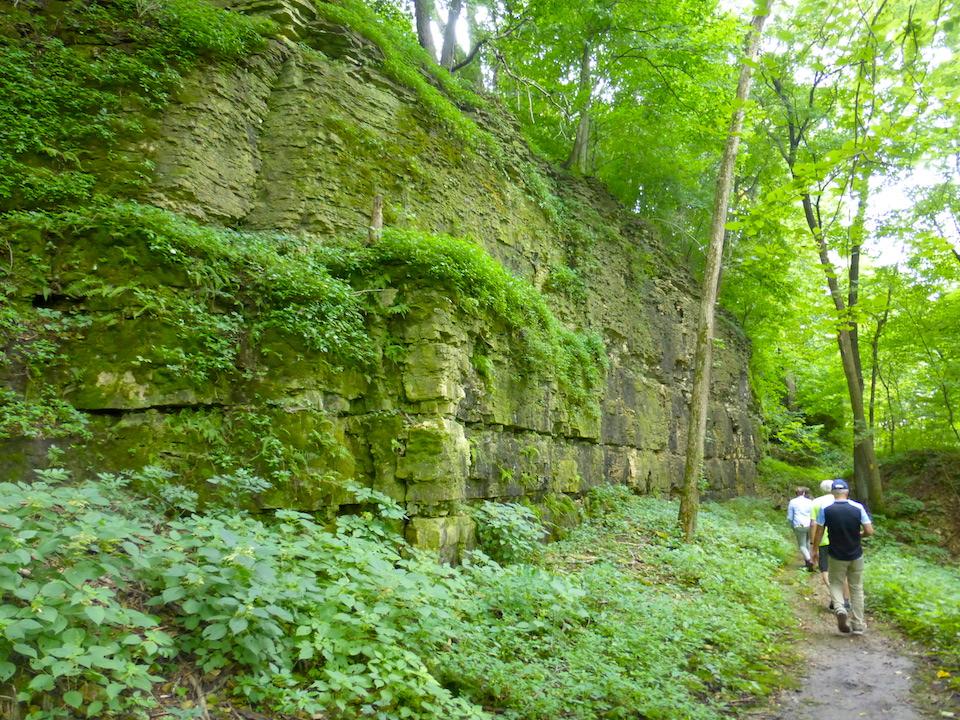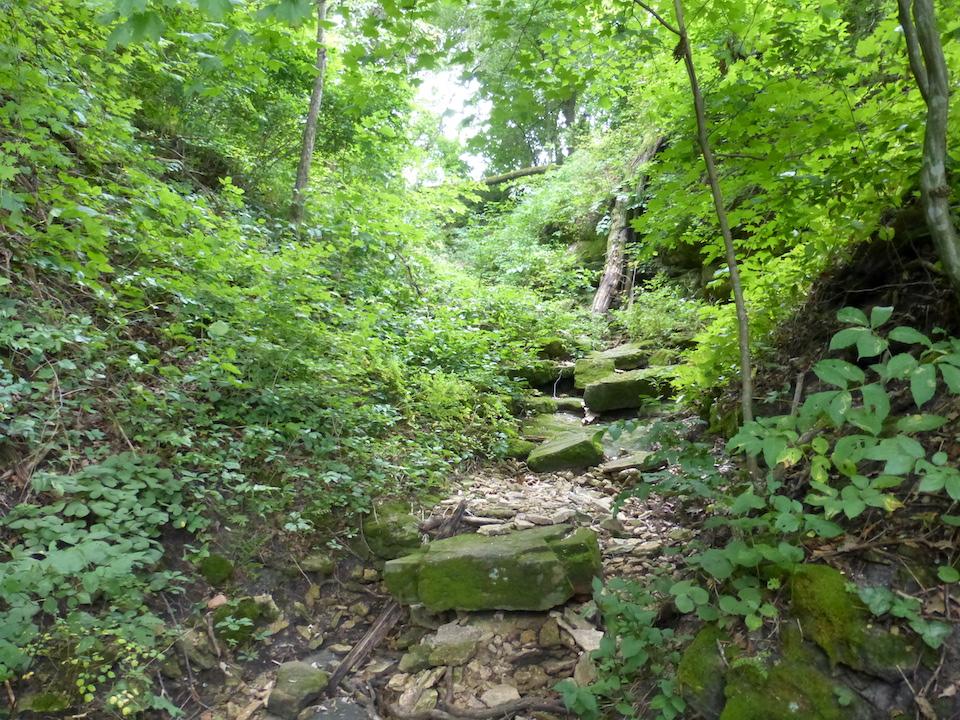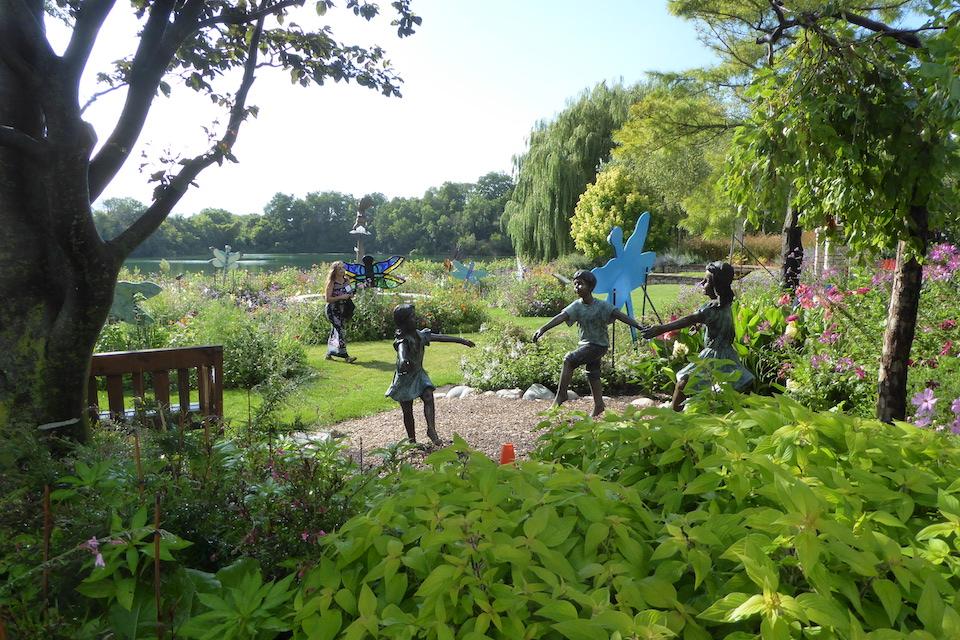
A portion of the Ice Age National Scenic Trail runs along a bluff near the Rock River near Janesville, Wisconsin/David and Kay Scott
During an August visit to Wisconsin we had an opportunity to hike portions of the Ice Age National Scenic Trail. The hikes were interspersed with downtime that included consuming Wisconsin’s food staple, cheese curds, and its unofficial state beer, Spotted Cow. Hiking a portion of the Ice Age Trail, the entire length of which meanders through Wisconsin, is reason enough to visit our nation’s 23rd state. Having the trail twist and turn through a land filled with cheese curds and Spotted Cow is a major bonus.
Wisconsin, like much of the northern United States, has been shaped over millions of years by glaciers that alternately crept southward from the Arctic before retreating back north. These massive ice flows carved lakes and sculpted the Wisconsin landscape, grinding and moving rocks, many of which remained behind when the climate warmed. Debris deposited by the melting glaciers help document a history of the state’s glaciation. While much of the evidence left by early glaciers has been erased by wind and water, the most recent glaciation’s farthest advance that occurred approximately 10,000 years ago provides a general outline of today’s Ice Age Trail National Scenic Trail.
Ice Age Trail was designated a national scenic trail by Congress in 1980 following years of effort by Wisconsin citizens, who had worked establishing trail segments. Today’s trail of approximately 1,200 miles continues as a work-in-progress with more than 600 miles of finished trail segments plus more than 500 miles of connecting routes.
From the eastern terminus in northeastern Wisconsin’s Potawatomi State Park, the trail meanders southwest near the Illinois state line before looping north and taking a sharp turn west to its western terminus at St. Croix Falls on the Minnesota border. Much of the eastern and western sections of the trail are relatively complete. Major portions of the long north-south stretch in the state’s midsection remain unfinished.

Sections of the Ice Age National Scenic Trail, such as the Devil's Staircase, can challenge you/David and Kay Scott
The trail is managed by a partnership of the National Park Service, the state’s Department of Natural Resources, and the Ice Age Trail Alliance. The Alliance, with a mission to “create, support, and protect a thousand-mile footpath tracing Ice Age formations across Wisconsin,” has 20 chapters based in more than 30 counties along the route. With occasional assistance of groups such the Boy Scouts, chapter members volunteer considerable time for trail construction and maintenance.
Our own experience hiking two southern stretches of the Ice Age Trail took place about 75 miles southwest of Milwaukee during a visit to Wisconsin’s Rock County. The county’s two largest communities are Beloit, a town of 37,000 on the Illinois border, and nearby Janesville, where the trail passes through multiple parks, including impressive Rotary Botanical Garden that was developed on the site of an abandoned sand and gravel quarry. Janesville, with a population of 64,000, is the largest urban community on the entire trail and considered its southern gateway.
Dennis James, chapter coordinator for Rock County Ice Age Trail and our local trail guide, commented that the Ice Age Trail differs from most of the other national scenic trails in that the Wisconsin trail, by design, passes through small towns where hikers have access to an occasional bed, hot meal, and shower. Some stretches actually follow a community’s main street. Small communities being located along the route offer the advantage of reducing the need for hikers to carry large amounts of food.

The Rotary Botanical Garden along the Ice Age National Scenic Trail/David and Kay Scott
Members of the Alliance are particularly proud of “trail angels,” local citizens who offer to provide shuttle service to and from segments of the trail. Some lodging operations provide shuttle service from the trail to their facility. Local citizens welcome showing off their communities to the hikers.
Ice Age National Scenic Trail is generally flat and doesn’t offer the great scenic views of other national scenic trails, such as the Appalachian National Scenic Trail. Hikers can also be besieged by mosquitos and deer flies, especially in the North Woods section heading toward Minnesota.
Dennis said the Alliance recognizes hikers who complete the entire trail with Thousand-Miler status, which conveys a certificate and patch. Hiking end-to-end generally requires 2 ½ to 3 months, although in 2019, 34-year-old trail runner Annie Weiss covered the entire trail in 21 days and 18 hours. This broke the previous best time recorded by a male runner in 2007.
Traveler postscript: The Ice Age National Scenic Trail is perfect for a fall hike.
David and Kay Scott are authors of “Complete Guide to the National Park Lodges” (Globe Pequot). Visit them at www.facebook.com/DavidKayScott



Comments
Wisconsin is truely a remarkable state with not just breathtaking view trails but it offers much , much more! It simply can't be covered adequately in one article.
We are older (very old)and can't hike anymore but we loved the pictures. They enabled us to imagine the beauty of the trails. We use to experience the longer, more challenging trails but now must be satisfied with the hikes described by others . I can only say we have to enjoy what we are able to do and I love following these articles and enjoyed this one as well . The Scotts do the walking for me and I greatly appreciate that.
I wish we could read all about Wisconsin's many wonders.You just must simply come here and see. We are passionate about our state and obviously in our opinion ,it's the BEST.
Agree. Anyone who thinks Wisconsin is generally flat should take up cycling and re-think that.
Yes! And a stretch of the IAT that has 40 some miles of road and/or bike path. Rock county is possible the worst example of the IAT. The author apparently missed what I feel is the most scenic section in Janesville - Devil's Staircase and the Aboretum.
Agreed. Wisconsin is not flat. The trail is beautiful. My favorite time to hike is when the leaves start to change.